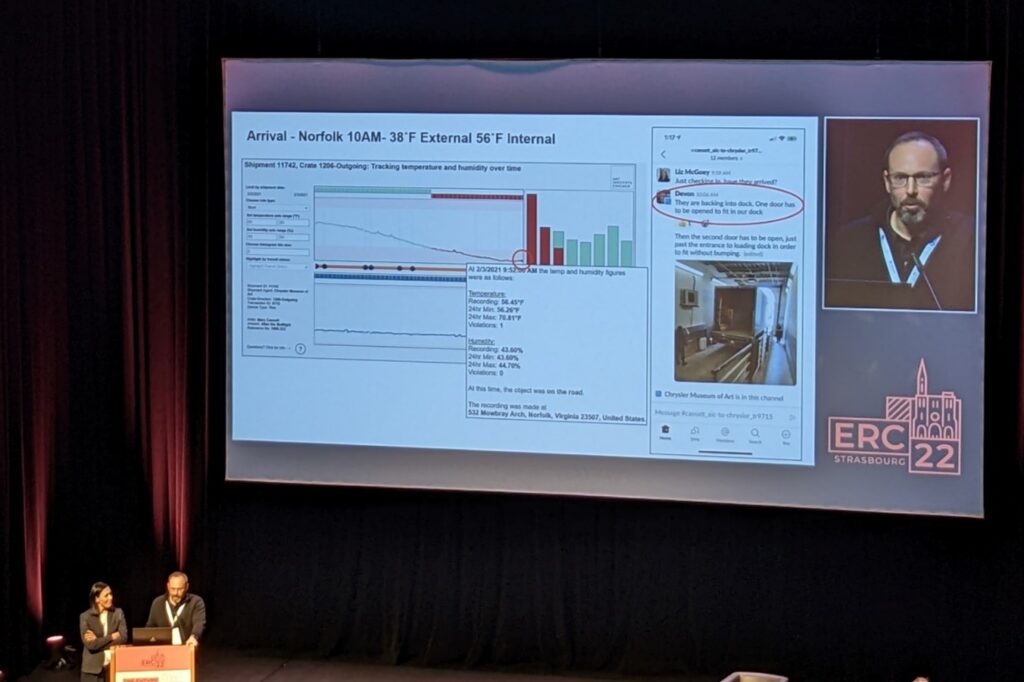European Registrars Conference: Virtual Couriers, 5th November 2022:
Digital Courier sessions. Presentations can be viewed here
- The virtual courier: New best practices in a post-pandemic world – Cayetana Castillo, Art Institute of Chicago & Matthew Norris, Art Institute of Chicago/ School of the Art Institute
- Digital Couriers: What Worked, What Went Wrong and Ideas for the Future – Sabina Schumpf, Basel
- Museum’s Registrars and Couriers at the post-Covid era: How do we go forward? – Isabel Bennasar Cabrera, Museo Nacional del Prado, Madrid
- Courier: born to be there live – Valentina Brambilla, Museo Egizio, Turin & Roberta Accordino
The covid-19 pandemic challenged much of the way registrars work, but one of the major issues was couriering. With international travel largely banned, how could we ensure the safe return of objects on loan? Then, as the world began to open up again, internal restrictions were often relaxed before international ones, meaning that while exhibitions and loans could begin again, sending in person couriers was still a challenge. Not only this, but as the Climate Emergency increases, the practice of sending physical couriers seems increasingly unsustainable. Many organisations, through either choice or necessity, have pivoted to using virtual couriers, and as we all adjust to this new way of working, it was great to hear from colleagues about their experiences of the benefits and downsides of virtual couriers.
I definitely wasn’t the only person who came away from the presentation by Cayetana Castillo and Matthew Norris from the Art Institute of Chicago feeling both very jealous, and wondering how many arms I’d have to twist at my own organisation to get something similar. They presented the Art Institute of Chicago’s interactive dashboard, which allows for in depth, real time tracking of information as shipments move across the USA and internationally. Physically supervision was delegated to contractors and other trusted partners, but staff at the AIC were able to monitor location, temperature, relative humidity, shock and vibration, and other concerns in real time, via a dashboard that also included other data sets such as internal database information, and external information such as weather conditions. In the example shown, the registrar and conservator were able to intervene when the temperature of the shipment kept dropping, liaising with the coordination from the shipping agent to discuss options. As well as being able to view the information in real time, the dashboard also stores historic information, allowing them to look for trends, such as when shipments are likely to be affected by low temperatures, and which type of packing can help mitigate against this best. I’m sure with this level of information, we’d all sleep a little more soundly as our shipments criss-cross the globe!

While the virtual courier may seem like an easy solution to the issues of in person couriering, other presentations in the group highlighted some of the challenges, both the obvious and the less so. Virtual couriers are often thought of as a cheaper option, and while it is true that it doesn’t require paying for airfare, hotels, and other subsistence costs, it can come with other costs, as highlighted by Sabrina Schumpf. The process of virtual supervision of an installation is often slower than if you had an in person courier, which means more staff time (and, if you use freelance staff, increased direct costs). Issues that would be easy to sort out in person, such as an unlabeled crate, can take much longer to resolve. And as noted by Valentina Brambilla and Roberta Accordino, when working across multiple time zones, virtual couriering can involve working through the night in order to allow the teams doing the physical installation to work in their own working hours (to avoid the handling mistakes that might come with being over tired).
One thing is clear: the virtual courier is here to stay. The challenge for organisations is to work out how to make this work for them, and the best way to do this is by sharing experiences, both positive and negative. I’m very grateful to the colleagues who generously shared their expertise, as well as to UKRG for the opportunity to attend.
Flora Fyles
Acting Registrar, Museum of London

 Instagram
Instagram  LinkedIn
LinkedIn  Twitter
Twitter  My Account
My Account